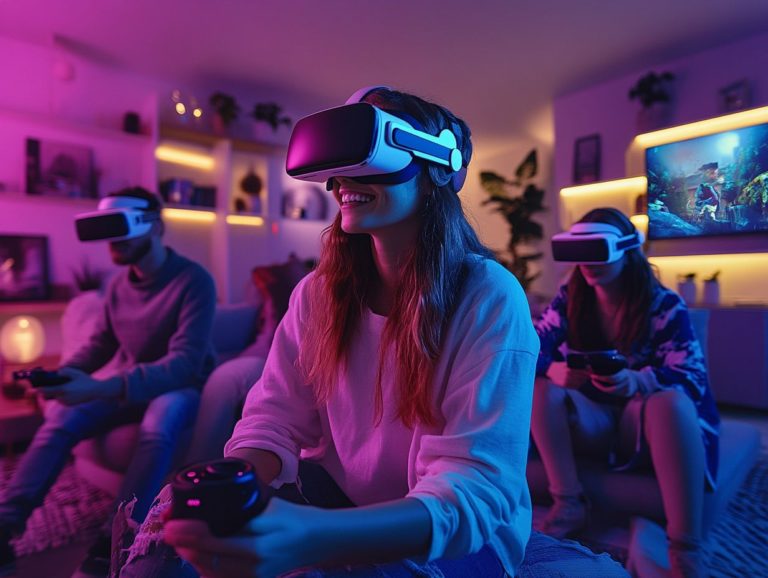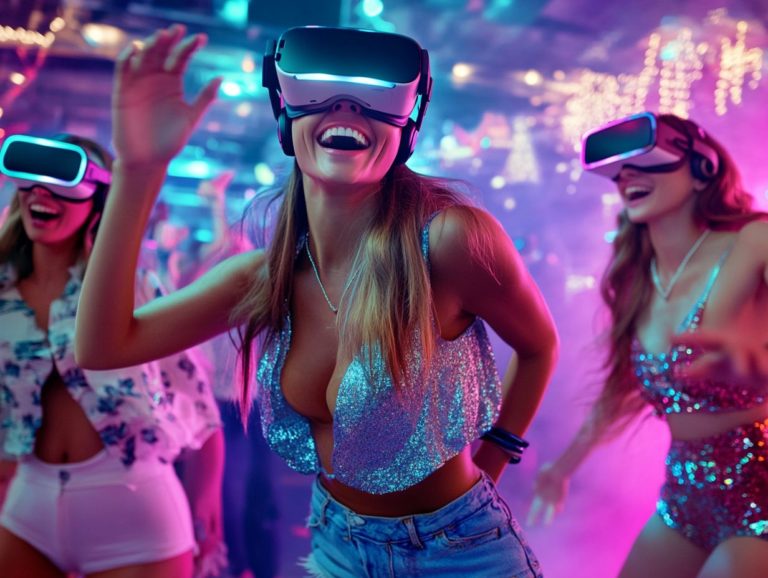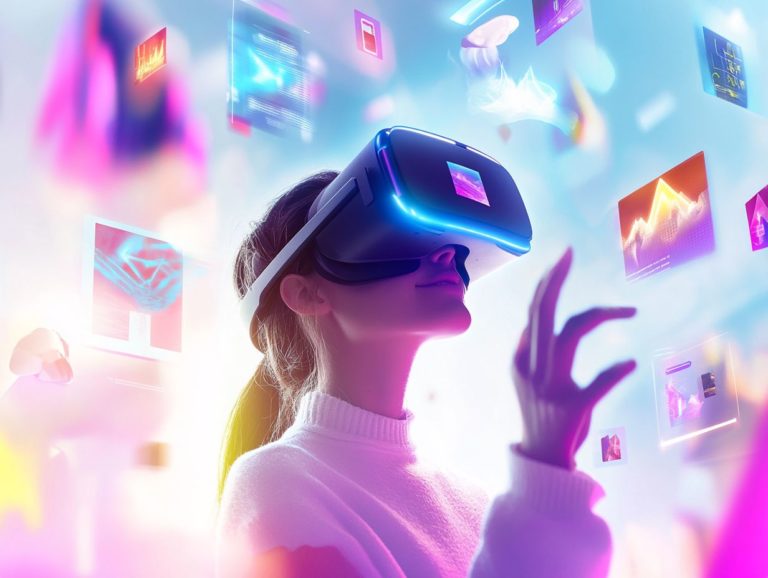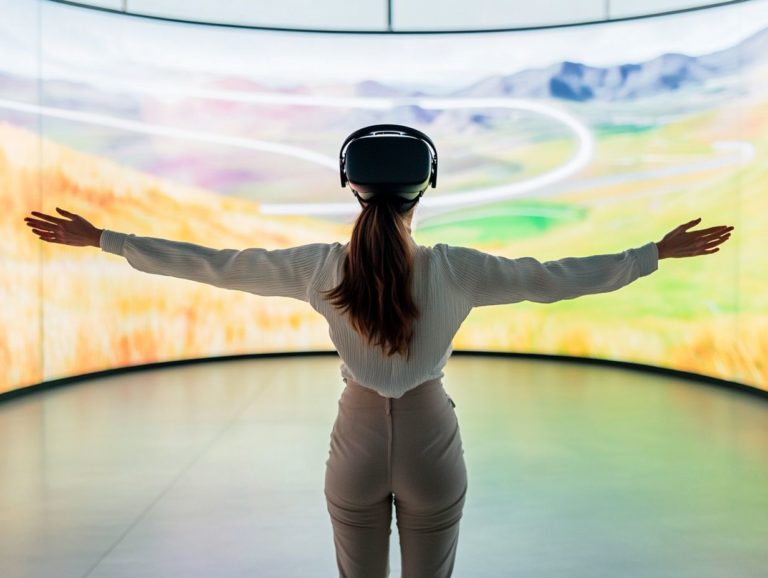best practices for vr gaming sessions
Virtual reality (VR) gaming is revolutionizing your interactive entertainment experience, immersing you in breathtaking worlds that feel astonishingly real.
This article delves into the myriad benefits of VR gaming, covering both physical and mental advantages while guiding you on how to prepare your space for the ultimate experience.
You ll discover best practices to elevate your gaming sessions, identify common pitfalls to steer clear of, and receive invaluable tips on post-gaming care to ensure you feel fantastic.
Get ready for an incredible adventure in gaming! Don t miss out on the thrilling world of VR gaming dive in now!
Contents
- Key Takeaways:
- Benefits of VR Gaming
- Preparing for a VR Gaming Session
- Best Practices for VR Gaming Sessions
- Common Mistakes to Avoid
- Post-Gaming Care
- Frequently Asked Questions
- What are the best practices for setting up a VR gaming session?
- How long should a VR gaming session last?
- What are some safety precautions to keep in mind during a VR gaming session?
- How should I prepare my body for a VR gaming session?
- What are some tips for avoiding motion sickness during a VR gaming session?
- What should I do after a VR gaming session?
Key Takeaways:
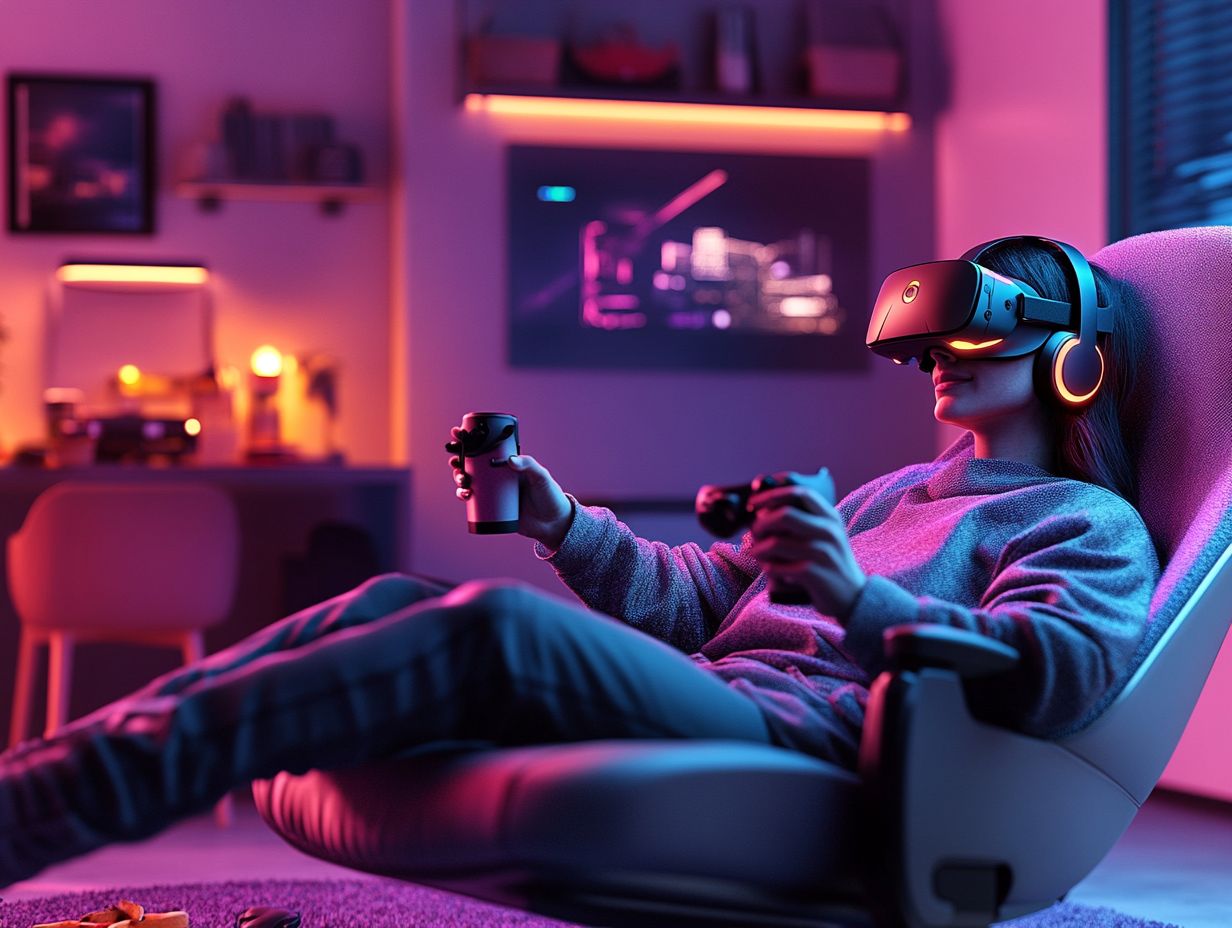
Ensure a comfortable and safe VR gaming experience by setting up equipment and the environment properly before each session. To prevent motion sickness, take frequent breaks, start with shorter sessions, and adjust game settings for comfort. For more tips on how to improve your VR gaming skills, remember to take care of your body and eyes after a VR gaming session by resting, hydrating, and avoiding excessive screen time.
What is VR Gaming?
VR gaming represents a groundbreaking form of interactive entertainment that immerses you in a three-dimensional, computer-generated environment.
This experience allows you to engage with the digital world in ways that traditional gaming simply can’t replicate.
With cutting-edge VR technology think headsets and specialized applications you re granted an unparalleled level of immersion and interactivity.
This fundamentally transforms how you play games.
The landscape of VR gaming has evolved remarkably, merging experiential learning with engaging gaming dynamics.
This encourages your interaction and skill enhancement. It also opens doors for VR training applications across various fields, enabling you to learn through realistic simulations.
As you navigate complex virtual environments, you ll develop strategic thinking and problem-solving skills that extend well beyond the gaming realm.
With continuous advancements in VR technology, every gaming session becomes an enticing opportunity for enjoyment and personal growth.
Benefits of VR Gaming
The advantages of VR gaming transcend simple entertainment, weaving in elements of immersive learning and skill enhancement.
These features can markedly elevate user engagement and retention.
With interactive components and realistic simulations, VR gaming presents distinctive training programs designed to refine both cognitive and physical skills across a range of fields, including healthcare and manufacturing.
Physical and Mental Benefits
Engaging in VR gaming doesn t just provide exhilarating entertainment; it also brings a wealth of physical and mental benefits.
These can enhance your overall well-being and skills.
The immersive nature of VR environments invites you to actively participate, leading to improved coordination, balance, and cognitive function.
This experience also builds your confidence through gamified challenges.
As you navigate intricate landscapes and tackle diverse obstacles, you re honing your motor skills and making real-world tasks feel more manageable.
These games help you relax, allowing you to escape daily pressures while stimulating your cognitive abilities.
The challenges you encounter during training experiences promote problem-solving and critical thinking, paving the way for personal growth.
This dynamic blend of physical engagement and mental stimulation elevates your gaming experience and fosters a profound sense of achievement and self-assurance.
In essence, VR gaming transcends mere play; it s a transformative pathway to overall enrichment.
Preparing for a VR Gaming Session
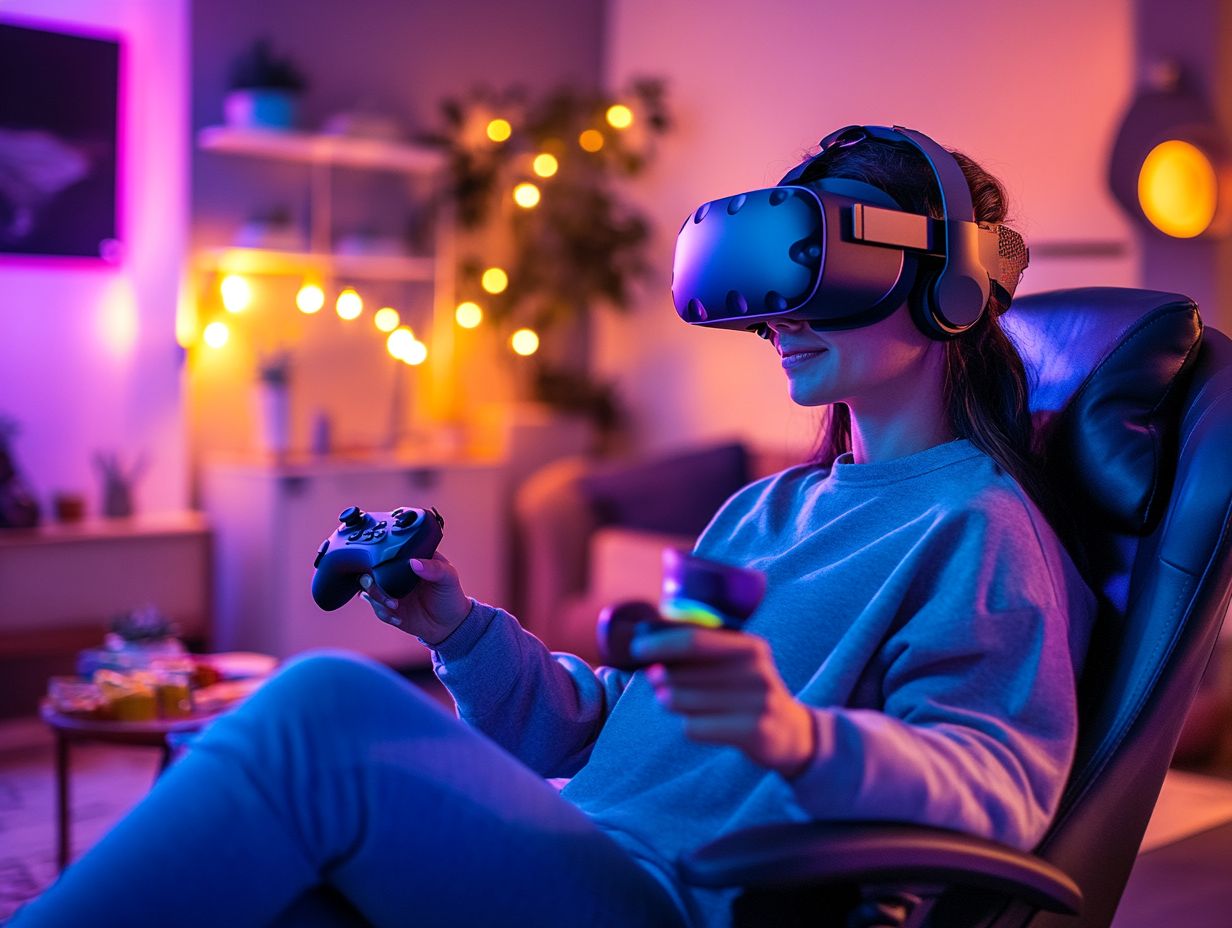
Preparing for a VR gaming session goes beyond simply donning the headset. It requires thoughtful attention to both your equipment and your surroundings, including how to create a safe VR gaming space, to ensure peak performance and comfort.
By adhering to established setup protocols and incorporating comfort measures, you can enhance your training strategies within these immersive experiences.
This preparation boosts your enjoyment and makes your gaming session more effective.
Discover the exciting world of VR gaming and start your adventure today!
Setting Up Equipment and Environment
Setting up your VR headsets and crafting the perfect environment is essential for an immersive gaming experience that boosts training effectiveness and ensures your comfort. A proper setup means clearing out space and adjusting the lighting to optimize your VR training. This way, you can engage fully without distractions pulling you away.
It is vital to arrange your seating and physical layout to support easy movement, minimizing the risk of collisions or accidents while you immerse yourself in the experience. Device management plays a key role in this preparation; ensuring all your VR equipment is fully charged and functioning optimally helps you avoid unwelcome interruptions.
By establishing clear guidelines for users such as how to wear the headsets properly and the importance of staying aware of your surroundings trainers can enhance the benefits of this technology. This approach allows for richer, more impactful learning experiences that resonate well beyond the session itself.
Best Practices for VR Gaming Sessions
To fully capitalize on the advantages of VR gaming, it is crucial to follow best practices, including tips for maintaining your VR gear, that ensure comfort, safety, and an engaging experience aligned with training assessments.
By adopting effective training strategies and prioritizing user comfort, you can significantly enhance your immersive experiences, particularly when learning how to create an immersive VR gaming environment, while reducing the chances of discomfort during extended play sessions.
Tips for Comfort and Safety
Prioritizing your comfort and safety during VR gaming sessions is essential for avoiding issues like motion sickness and eye strain, which can detract from the immersive experience you crave. To enhance your experience, consider creating a VR gaming community that shares tips and tricks for best practices.
Implement specific safety measures and comfort techniques to elevate your VR training and extend your gaming sessions without discomfort. First, taking regular breaks is key; stepping away from the headset for just a few minutes can significantly lower your risk of motion sickness while giving your eyes a much-needed rest. For more tips on creating an immersive VR environment, consider optimizing your setup.
Adjust the headset so it fits snugly but comfortably it can work wonders in minimizing strain. Also, pay attention to your play environment; ensuring you have ample space to move around freely will help prevent physical accidents.
Incorporate eye exercises and use anti-glare lenses to offer additional protection against eye fatigue, ensuring that the wonders of virtual reality remain a source of joy rather than discomfort. Get ready for an exhilarating experience that keeps you comfortable and engaged!
Common Mistakes to Avoid
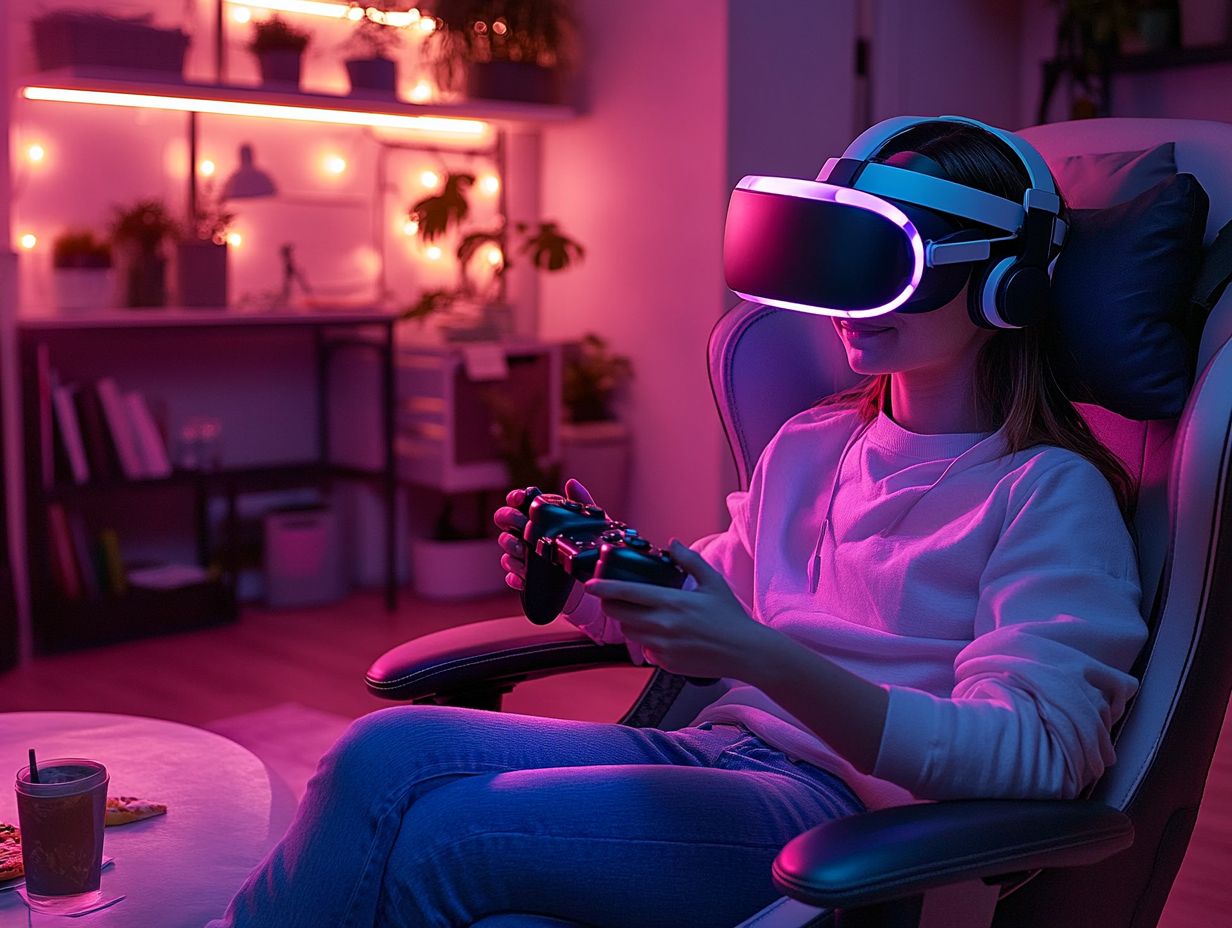
Avoiding common mistakes in VR gaming is crucial for ensuring a seamless experience that fosters effective performance evaluation and enjoyable immersion.
By staying attuned to potential pitfalls such as improper equipment setup and overlooking comfort measures you can significantly elevate your gaming sessions and reduce discomfort.
How to Prevent Motion Sickness
Preventing motion sickness during VR gaming is essential for your comfort and the overall effectiveness of your training. It allows you to immerse yourself fully in the experience without distractions.
Employ strategies like getting used to the VR environment slowly and taking breaks to enjoy your VR sessions without the nagging discomfort of motion sickness.
Make environmental adjustments such as optimizing lighting, minimizing screen glare, and ensuring your headset fits properly to enhance your overall experience.
Focusing on stable points within the virtual environment can help alleviate sensations of motion discomfort. Incorporate brief rest periods and engage in light physical movement to recalibrate your senses, facilitating a smoother transition back into the virtual world.
By understanding and applying these strategies, you can cultivate a more enjoyable and effective VR training atmosphere, transforming challenges into valuable growth opportunities.
Post-Gaming Care
Implementing effective post-gaming care is crucial for recovering from your VR gaming sessions and alleviating issues like eye strain and fatigue. This practice ultimately enhances your overall gaming experience.
Incorporate comfort measures and allow yourself time to relax to ensure a seamless transition back to reality after those immersive VR adventures. To enhance your setup, check out how to optimize your VR setup for performance and try these post-gaming care tips today to elevate your VR experience!
Recovering and Avoiding Eye Strain
Recovering from eye strain after a thrilling VR gaming session requires intentional recovery techniques and comfort measures to alleviate discomfort and promote relaxation. By integrating practices like taking regular breaks and performing eye exercises, you can immerse yourself in the experience without suffering from long-term consequences.
Using these tips not only enhances your enjoyment but also protects your visual health. You might want to adopt the 20-20-20 rule: every 20 minutes of play, look at something 20 feet away for 20 seconds.
Adjust your headset settings for optimal distance and comfort to minimize strain. Using lubricating eye drops can help combat dryness, which often worsens during extended sessions. Simple neck and shoulder stretches can enhance relaxation, ensuring both your body and eyes feel revitalized.
By implementing these strategies, you create a more enjoyable gaming experience, allowing you to dive into virtual worlds without discomfort.
Frequently Asked Questions
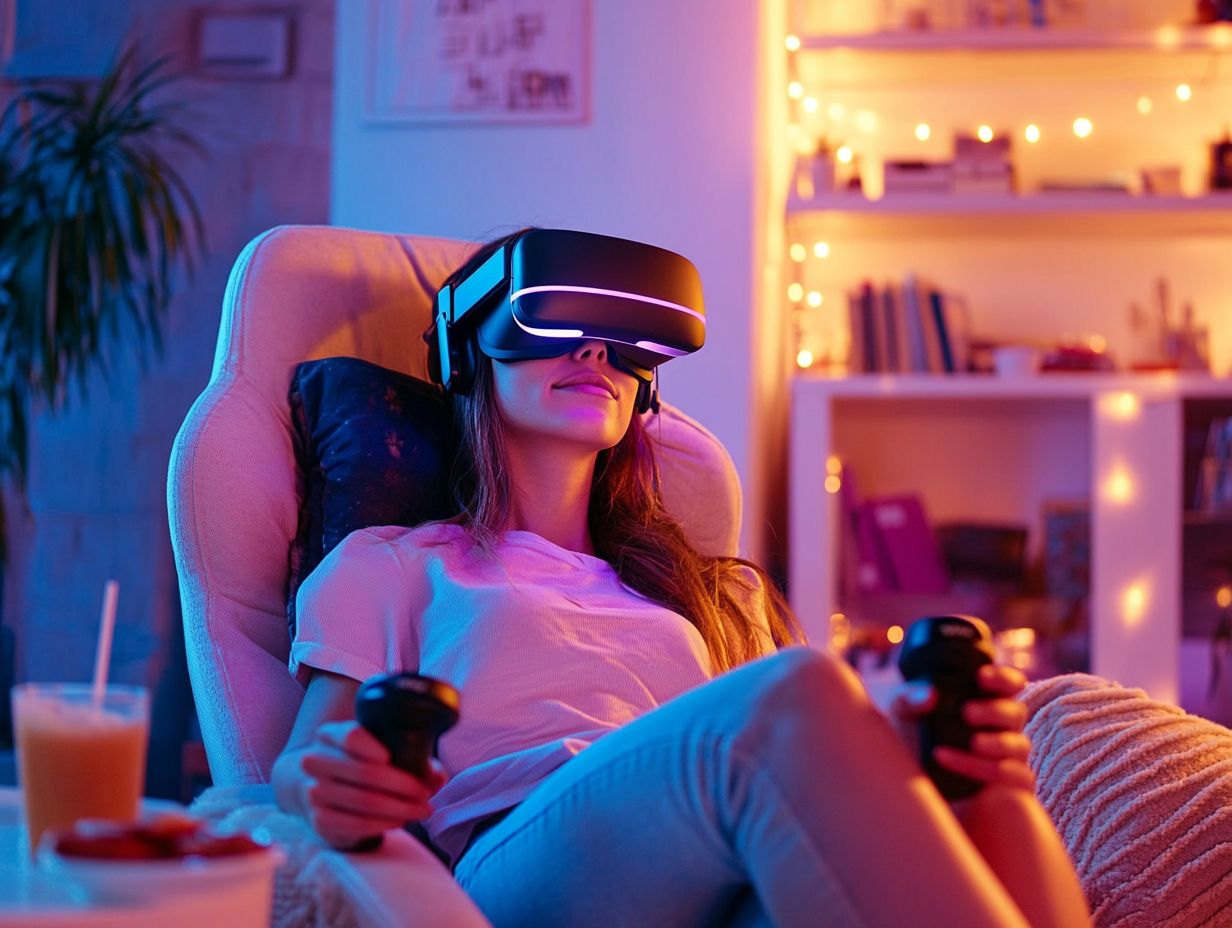
What are the best practices for setting up a VR gaming session?
First, clear your space now to avoid any accidents. Remove furniture, loose objects, and ensure there are no tripping hazards. It s also important to have a stable and clutter-free floor for the player to stand on. Make sure the VR headset and controllers are fully charged and that the gaming space is well-lit.
How long should a VR gaming session last?
The recommended duration for a VR gaming session is around 30 minutes. This allows for an immersive and enjoyable experience without causing discomfort or fatigue. For more ideas on maximizing your experience, check out these tips for enjoying VR alone or with friends. Remember to take breaks in between sessions to rest your eyes and stretch your muscles, especially if you are prone to motion sickness.
What are some safety precautions to keep in mind during a VR gaming session?
One of the most important safety precautions is to have a designated spotter who can monitor your movements and alert you of any potential hazards. Set boundaries for the play area and make sure to stay within those limits. It s also a good idea to have a fan or air conditioning available to prevent overheating.
How should I prepare my body for a VR gaming session?
Before starting, stretch and warm up, focusing on your neck and shoulders to prevent muscle strains or discomfort during gameplay. Drink plenty of water and avoid heavy meals or alcohol beforehand.
What are some tips for avoiding motion sickness during a VR gaming session?
Motion sickness can be an issue for some players. Adjust the VR headset correctly and take breaks every 15-20 minutes. Having a fan or air conditioning can help keep you cool and reduce feelings of dizziness or nausea.
What should I do after a VR gaming session?
After playing, take time to cool down and relax. Stretch, drink water, and close your eyes for a few minutes. Clean your VR headset and controllers with a sanitizing wipe to prevent the spread of germs, and store your equipment properly to keep it in good condition for future use.

